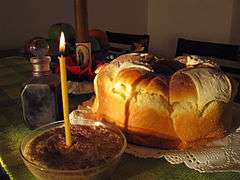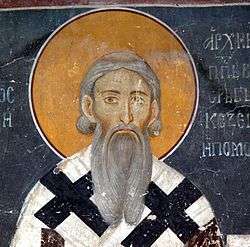Slava
| Slava | |
|---|---|
 Slava prepared for the veneration of John the Baptist. | |
| Observed by | Serbian Orthodox Christians |
| Significance | Veneration of the family's patron saint |
| Observances | church services, family and other social gatherings, |
The slava ("celebration"; Serbian Cyrillic: слава) is a Serbian Orthodox Christian tradition of the ritual glorification of one's family's patron saint. The family celebrates the Slava annually on the saint's feast day.
In November 2014 it was inscribed in UNESCO Intangible Cultural Heritage Lists.
Overview
The Slava is the family's annual ceremony and veneration of their patron saint, a social event in which the family is together at the house of the patriarch. The Slava also brings friends to the house, regardless if they have the same Slava. The family saint is inherited from the patriarch (head of the household) – from father to son, while women do inherit the patron saint of their husbands upon leaving their families. As several patron saints are venerated twice a year, the main day is the Slava, while the secondary one is called preslava. Some families may celebrate another patron saint in the case when the wife is the only left of her kin, in respect to her family. In cases where the daughter's husband has joined (traditional) household of the parents-in-law ("prizet"/"domazet" = "by-son-in-law"/"son-in-law-in-the-home"), the wife's father's slava is celebrated as the main one (when guests are expected and/or invited) and the son-in-law's only as an additional lesser one (when just a festive meal is prepared for the family and no manual work is carried out, but no guests are expected).
The tradition is an important ethnic marker of Serb identity.[1] Serbs usually regard the Slava as their most significant and most solemn feast day.[2] The tradition is also very well preserved among the Serb on all 5 continents.[3] Apart from Serbs, the custom is also practised by some Orthodox Macedonian families.[4]
| “ | Gde je Slava, tu je Srbin ("Where there is a Slava, there is a Serb") | ” | |
| — Serbian proverb, [1] | |||
Origin

The tradition has its origin in the Medieval Serbia, connected to Saint Sava, the first Archbishop of the Serbs. There are indications that the institution of the slava dates from Saint Sava, that "in his understanding and tactful approach to Serbian folk religion", he "seems to have found a compromise formula satisfactory to both his people's tradition and the requirements of Byzantine theology".[5] The slava is a reinterpretation of a pagan rite:[6] the ancestor-protector became a Christian saint,[7] frequently St. Nicholas,[6] with the pagan rite being reduced of many religious elements and frequent ceremonies and becoming a social event with the annual meeting of the family and friends.[7][8]
Modern history
When Bulgaria invaded southern Serbia during World War I, it regarded all who celebrated the Slava as Serbs and enemies, as Bulgarians do not have the custom. For instance, when Bulgarian commander Protogerov was ordered to inflict reprisals in the east of Kumanovo for an earlier attack, and the population quickly declared as Bulgarians before the measures were taken (as to avoid punishment), his aides had the idea of asking the people who celebrated Slava; those who did were shot.[9]
The increased effective geographic mobility brought about by the post World War II urbanization of a previously highly agrarian society, combined with the brutal suppression of Serbian Orthodox traditions under the Communist rule, has made some aspects of the custom more relaxed. In particular, in the second half of the 20th century it became common to see traditional patriarchal families separated by great distances, so by necessity Slava came to occasionally be celebrated at more than one place by members of the same family.
While the Slava kept something of a grassroots underground popularity during the Communist period, the post-Communist revival of Christian traditions has brought it a great resurgence. It is recognized as a distinctly (if not quite exclusively) Serbian custom, and today it is quite common for nonobservant Christians or even atheists to celebrate it in one form or another as a hereditary family holiday and a mark of ethnocultural identification.
In November 2014 it was inscribed in UNESCO Intangible Cultural Heritage Lists.
The custom is also helpful in genealogical studies as an indicator in kinship relations between families, tracing one's family to a specific region, etc.
Celebration

The ritual foods that are prepared for the feast are the slavski kolač (or simply kolač) = a ritual bread, and koljivo (or žito), a dish of minced boiled wheat, sweetened and sometimes mixed with chopped walnuts. The top of the kolač is adorned with the Christian cross, the peace dove, and other symbols. The koljivo is a symbol of the Resurrection of Christ (cf. "if the grain does not die..." in the Gospel) and partaken in memory of the dead (deceased family members).
Depending on whether the celebration falls in a period of fasting, the rest of the feast consists of a meal with a variety of food that is either all animal-except-fish/seafood-free (posno, and that includes sweets also obligatorily made without eggs and dairy) or with dairy, eggs, and the meat of mammals (usually including roast piglet, lamb) and poultry allowed (mrsno); thus, colloquially, slavas can be referred to as posna or mrsna.
The family attends church services and partakes in Holy Communion on the feast day. Following the service, traditionally, the parish priest is received in the family's home or the family brings the slavski kolač to the church. The parish priest performs a small service which entails venerating the patron saint's memory, blessing the kolač and koljivo, as well as lighting the "slava candle". Though not necessary, it is common for the priest to bless the house and perform a small memorial service for dead relatives.
The most common feast days are St. Nicholas (Nikoljdan, 19 December), St. George (Đurđevdan, 6 May), St. John the Baptist (Jovanjdan, 20 January), St. Demetrius (Mitrovdan, 8 November), St. Michael (Aranđelovdan, 21 November) and St. Sava (Savindan, 27 January). All these dates are given in accordance to the official Gregorian calendar and not the Julian calendar used by the Serbian Orthodox Church).
Many Serbian communities (villages, cities, organizations, political parties, institutions, companies, professions) also celebrate their patron saint. For example, the city of Belgrade celebrates the Ascension of Jesus Christ as its slava.
-

Slavski kolač, a type of bread that has an important role in the celebration of the Slava.
-

Koljivo
-
Church prepared for the celebration of a Slava, Trebinje, Republika Srpska, Bosnia and Herzegovina.
See also
| Part of a series of articles on |
| Serbs |
|---|
 |
|
Native communities |
|
Related people |
Annotations
- Krsna slava (Крсна слава, "christened Slava") and Krsno ime (Крсно име, "christened name")
References
- 1 2 Ethnologia Balkanica. LIT Verlag Münster. pp. 70–. GGKEY:ES2RY3RRUDS.
- ↑ Celia Jaes Falicov (1991). Family Transitions: Continuity and Change Over the Life Cycle. New York City: Guilford Press. p. 219. ISBN 978-0-89862-484-7.
- ↑ Michael B. Petrovich; Joel Halpern (1980). "Serbs". In Stephan Thernstrom; Ann Orlov; Oscar Handlin. Harvard Encyclopedia of American Ethnic Groups (2nd ed.). Harvard University Press. p. 925. ISBN 978-0-674-37512-3.
- ↑ Jovan F. Trifunovski. "Породична слава и сличне славе у охридско-струшкој области" (PDF). Bulletin of the Ethnografical Institute SASA, vol XLV (in Serbian).
- ↑ Serb World. 3–4. Neven Publishing Corporation. 1982. p. 5.
- 1 2 A. P. Vlasto (1970). The Entry of the Slavs Into Christendom: An Introduction to the Medieval History of the Slavs. CUP Archive. pp. 223–. ISBN 978-0-521-07459-9.
- 1 2 The folk arts of Yugoslavia: papers presented at a symposium, Pittsburgh, Pennsylvania, March 1977. Duquesne University Tamburitzans Institute of Folk Arts. 1976. p. 41.
- ↑ Folk Culture: Folk culture & the great tradition. Institute of Oriental and Orissan Studies. 1983. p. 113.
- ↑ Đoko M. Slijepčević (1958). The Macedonian Question: The Struggle for Southern Serbia. American Institute for Balkan Affairs. p. 77.
"Then Protogerov's aides had an idea: they asked who celebrated Slava. Those who did so were shot, since the celebration of the slava is a sign that one is a Serb: it is a custom which the Bulgars do not ...
; Gilbert in der Maur (1936). Die Jugoslawen einst und jetzt: Jugoslawiens Aussenpolitik. Günther. p. 330.
Further reading
- Hrizostom Vojinović (1963). Srpska slava ili krsno ime. Mala religiozna biblioteka 23.
- Jovan Todorovich (1978). Serbian Patron Saint (Krsna Slava).
- Dimitrije Kiki Popadic (1999). Krsna Slava Among the Serbs: A Case for Contextualized Reinterpretation. Fuller Theological Seminary.
- Љубисав Милосављевић, ed. (2005). Домаћине, срећна ти крсна слава. ИТТ Национал. ISBN 978-86-85233-37-1.
- Milan T. Vuković (1972). Narodni običaji, verovanja i poslovice kod Srba.
- Krsto Milovanović (1997). Slave. Narodno delo.
- Mile Nedeljković (1991). Slava u Srba. Vuk Karadžić.
- Bratislav Grubačić; Momir Tomić (1988). Srpske slave: narodni običaji i verovanja, narodne pesme i zdravice, slavska jela i pića. Litera.
- Dimitrije M. Kalezić (2000). Krsne slave u Srba. Narodna knjiga-Alfa.
- Влаховић, П. (1998). Крсна слава и њена улога у породичном и друштвеном животу код Срба. В: Етно-културолошки зборник. Књ. ІV, Сврљиг, 23-32.
- Чајкановић, Веселин. "Мит и религија у Срба." Српска књижевна задруга 443 (1973): 128-153.
- Vasić, M. (1985). Slava-Krsno ime. u: O krsnom imenu-zbornik. Beograd: Prosveta, 218-219.
- Radenković, L. R. (2013). Slava: The Serb family feast. Zbornik Matice srpske za slavistiku, (84), 9-23.
- Pavković, Nikola F. (2015). "The Slava or Patron Saint's Day among the Serbs" (PDF). Glasnik Etnografskog instituta SANU. 63 (1): 123–145. doi:10.2298/GEI1501123P.
External links
| Wikimedia Commons has media related to Slava. |
| Look up slava in Wiktionary, the free dictionary. |
- Ranković, Ljubomir. "Krsna Slava" (in Serbian). Svetoslavlje.
- "Serb families honour their saints with Slava celebrations". BBC. 3 March 2013.
- Intergovernmental Committee for the Safeguarding of the Intangible Cultural Heritage (November 2014). "Slava". Nomination file no. 01010 for Inscription on the Representative List of the Intangible Cultural Heritage of Humanity in 2014. Paris, France: UNESCO.